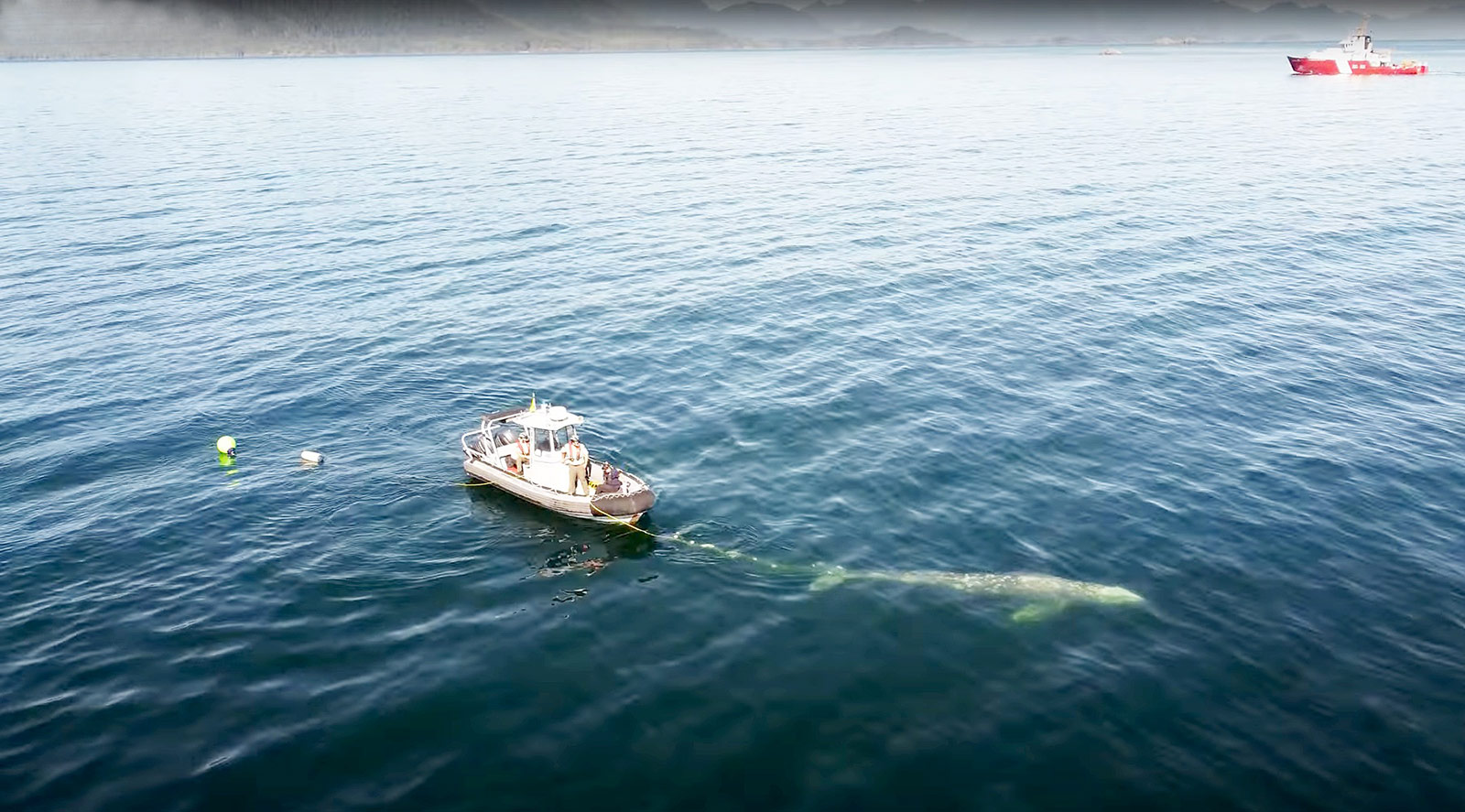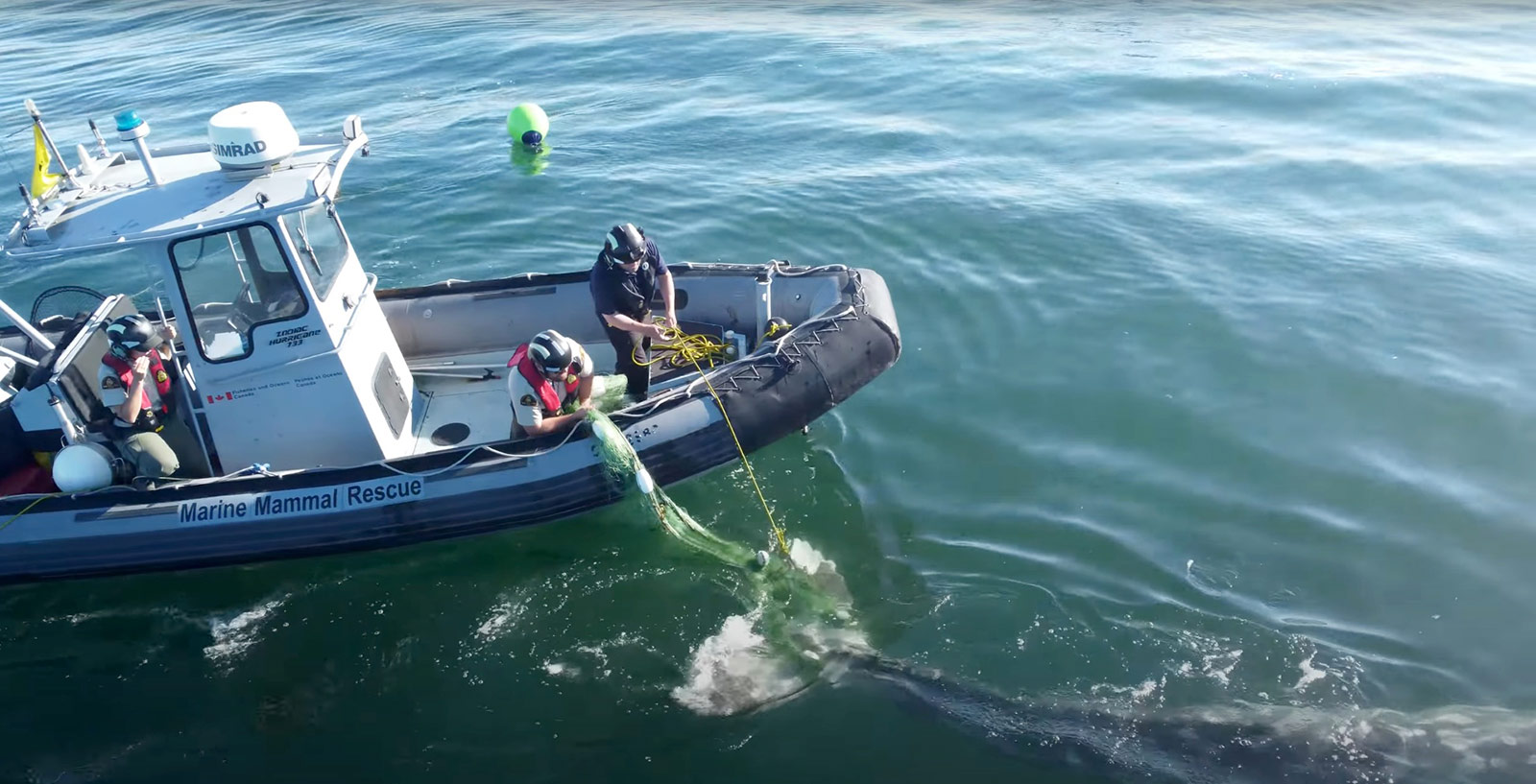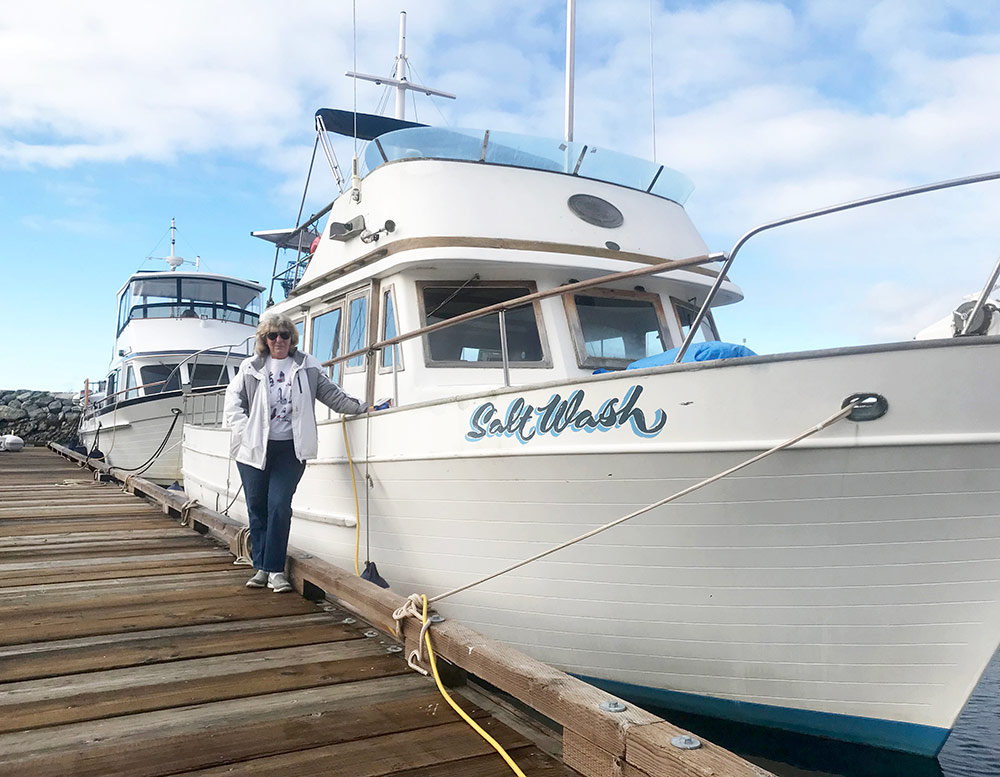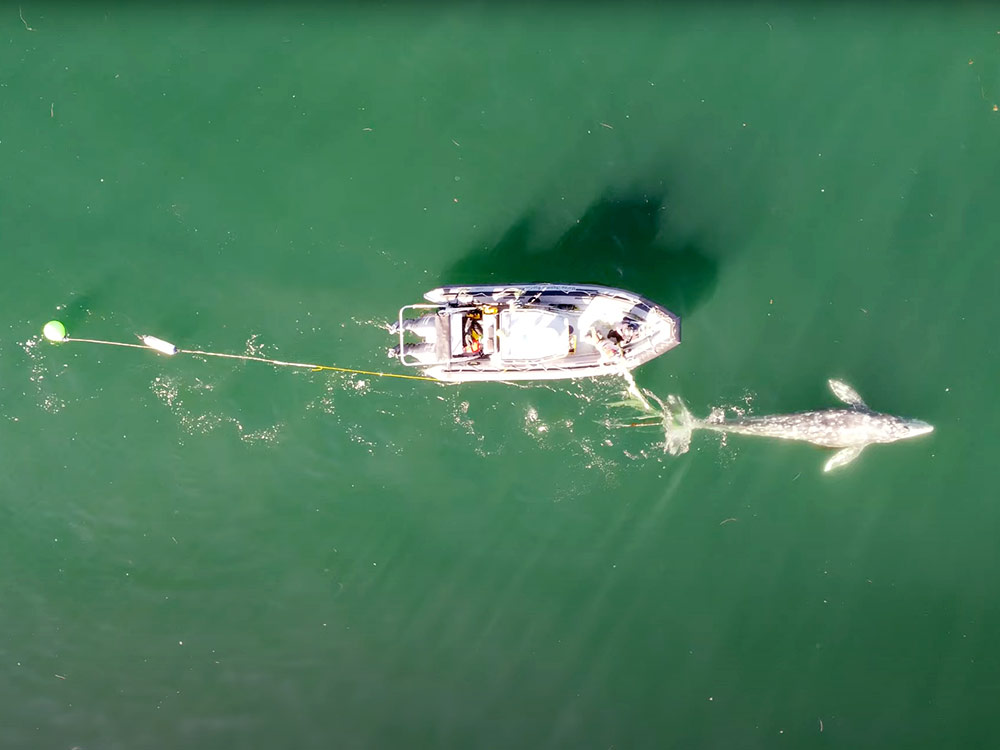Last summer, Fisheries and Oceans Canada’s marine mammal rescue co-ordinator Paul Cottrell received a call. A grey whale had been foraging in shallow water in Nootka Sound near Yuquot, B.C., off the west coast of Vancouver Island, when it got caught in a salmon fisher’s gillnet — a curtain of netting held vertically in the water by strings of floats and weights.
The whale became upset and aggressive, entangling itself further. Darkness was setting in, so the fisher phoned the DFO’s 24-7 Observe, Record, Report line operators, who called Cottrell.
What followed was a week-long attempt to free the whale.
Cottrell arrived in the area the next day, but neither his team nor local boaters who were keeping an eye out, spotted the whale.
Three days later and 35 kilometres north of Yuquot, in Esperanza Inlet, a recreational vessel saw the whale swim by, dragging the gillnet in its wake. When the sighting was called in, DFO officers responded and attached a floating satellite tag to the fishing gear while Cottrell and his team boated up to the area from Nootka Sound. The weather was good, and Cottrell’s team, working closely with a support vessel, spent four hours with the whale, using a specialized cutting tool — a sharp knife mounted to the end of a long pole — to remove a significant amount of the gear.
When they checked the whale’s position the next morning, it had moved more than 60 kilometres offshore and was heading north. It wasn’t until a few more days had passed that the whale moved back towards shore, near Brooks Peninsula — another 70 kilometres north — and it was safe to reapproach and try again.
When the crew reached the whale, Cottrell says it was “visibly tired” from its week-long struggle. If the gear could not be removed, the whale would almost certainly grow weaker and die. But the fact that the whale was tired meant it would struggle less and be easier to free.
Again using a specialized cutting tool, Cottrell worked at releasing the gillnet, moving towards the tailstock — the narrow, muscular part of the whale that links its body to its fluke — where it had gotten stuck.
Finally, the whale could sense freedom. It gave a burst of energy and peeled free.
“It was just one of those great moments for the whole team,” Cottrell says. “When you cut the gear and see it go free, it’s incredible.”
Estimating whale entanglements
Cottrell disentangled his first whale over a decade ago, when he freed a locally famous humpback nicknamed Twister from a string of commercial prawn traps in Knight Inlet. Since then, he’s helped free more than 50 whales. He’s seen such incidents steadily increase over his 24-year career with DFO.
In B.C., the increase in entanglements comes two by two with a success story: humpbacks, fin whales and even right whales have been returning to B.C.’s coast after they were largely extirpated by whaling in the early- to mid-20th century. (The eastern North Pacific Ocean population of grey whales saw an increase post-whaling, too, but that peaked in 1998.)
Nearly 25,000 whales were harvested on B.C.’s coast between 1908 and 1967, according to Hakai magazine. And while populations have rebounded somewhat, they’re not out of hot water — Canada’s list of wildlife species at risk identifies B.C.’s humpbacks and grey whales as species of “special concern,” fin whales as “threatened” and right whales as endangered.
It used to be that settlers killed whales for commercial gain — finding so much gain, in fact, that we nearly extinguished them from the coast entirely. Today, we love whales so much we map their genealogies, give them names and nicknames and dedicate entire museums to them. And we also maim and kill them completely accidentally and incidentally, while fishing for other species.
Every time a whale gets stuck in fishing gear, the stakes are high. If a rescuer can’t reach the whale quickly enough, it risks severe injuries or a slow, agonizing death.
For rescuers, the work, while exhilarating, is dangerous.
Cottrell is one of a group of 15 global experts who share their hard-won knowledge and follow strict guidelines. They always work with a second boat that acts both as a spotter and a rescuer, in case the primary vessel capsizes; they work their way from the end of the trailing debris back towards the whale, maintaining as much distance as possible for as long as possible; and they never enter the water to facilitate removal of gear.
A January story from the Guardian says at least three rescuers have died worldwide while working to free whales over the past two decades. Most recently, New Brunswicker Joe Howlett died in a tragic accident in 2017 after cutting crab trap lines off a right whale in the Gulf of St. Lawrence.
While it’s not unheard of for toothed whales like orcas (also listed as endangered) to require rescue from time to time, they’re smaller and wily and can often free themselves.
Toothless, or baleen whales, such as humpbacks and greys, are larger, have bigger fins and tend to feed by swimming through the water with their mouths open, creating more opportunities to get stuck in fishing nets and ropes. Humpbacks in particular are known for getting caught, with one ongoing tailstock scarring study indicating that almost 50 per cent of B.C. humpbacks have experienced entanglements.
Cottrell is the only person on the West Coast of Canada trained in large marine mammal rescue. The area he covers is massive, stretching from B.C.’s southern border with Washington up to the province’s northern border with Alaska.
But he’s figured out a way to locate distressed whales in the vastness of the ocean so that it’s no longer, as he says, like “finding a needle in a haystack.” He has trained 20 teams up and down the coast how to attach a satellite tag buoy to the debris trailing an entangled whale. These teams include DFO officers, First Nations representatives and NGOs. When the whale is spotted, the local team can respond quickly, attaching the buoy to track the whale while Cottrell and his team travel to the area.
Cottrell now also uses drones as an assessment tool — first, to fly over the whale and get a bird’s eye view of what exactly the whale is struggling to escape, and after a successful rescue, to double-check that the whale is fully free of gear.
Still, as good as it feels to liberate a great creature to once again roam the sea, Cottrell says the overarching goal is to prevent entanglements in the first place.


Sean Brillant, a senior conservation biologist with the Canadian Wildlife Federation and an adjunct professor in the department of oceanography at Dalhousie University, says that the West Coast has a lot to do to catch up when it comes to research about the prevalence of entanglement.
On the East Coast, Brillant says, scarring studies have shown that up to 85 per cent of right whales becomes entangled during their lives and up to 25 per cent of the population gets entangled every year.
“Similar scarring studies have been done for fin whales in the Gulf of St. Lawrence, and the percentage is upwards of 60 per cent of the population there,” Brillant says.
While many of these whales work their way out of whatever they’ve gotten stuck in, Brillant underscores that the issue goes beyond whether a whale survives.
“Recent research on growth and reproductive rates in right whales in particular has demonstrated that the population is stunted compared to how fast they should be growing,” Brillant says. “Calves are smaller, the calving rate is lower. And the speculation for this is because of the injuries they’re receiving as a result of these entanglements.
“So entanglements are not only about lethal effects. The sub-lethal effects may be really important for conservation considerations as well.”
It’s also important to note, Brillant says, that the injuries sustained can be “horrific.” He references veterinarian Michael J. Moore’s thoughts on seeing the gruesome injuries and slow deaths suffered by whales who get stuck in fishing ropes and nets.
“The ways in which these animals die, especially in fixed fishing gear that they become entangled in and swim off with, would raise substantial concern with consumers of seafood were they to be aware of what they were enabling,” Moore wrote in a 2014 essay.
The Canadian Wildlife Federation recently brought in an entanglement mitigation specialist, Wendy Szaniszlo, to begin collecting and analyzing data from the West Coast.
Szaniszlo, who is on leave from the DFO to pursue the project, says that researchers don’t yet have the data they need in order to really understand the extent of the problem off B.C.’s coast.
“That's going be the first step,” Szaniszlo says, “to get a better understanding of the the situation here in terms of what species are mostly getting entangled, what kind of gear or debris they’re getting entangled in, what particular fishery that’s related to, in what particular location, if we can figure that out. And also if there's a certain time of year that it's happening.”
According to Cottrell, the DFO has been receiving between 18 to 27 confirmed reports of whale entanglement annually over the past few years.
But Brillant and Szaniszlo point to cryptic mortality and scarring studies indicating that rates of entanglement are probably much higher than this.
The International Whaling Commission estimates that 300,000 large whales and dolphins die globally due to entanglements with fishing gear each year. Many more perish after getting caught up in other marine debris.
Szaniszlo is currently working with stakeholders, including the DFO, to gather West Coast-specific data. After that is accomplished, Szaniszlo says it will be her job to work with fishers to develop solutions.
Any line in the water is a hazard
On B.C.’s northern Sunshine Coast, Susan MacKay runs the Wild Ocean Whale Society. A 24-7 camera set up at her house captures a view of the Georgia Strait: the northern-most tip of Texada Island, snowy mountains in the distance on Vancouver Island and everything transient — including ferries and fishing boats, as well as whales, porpoises, sea lions and dolphins.
MacKay and her small team take in data about marine mammal sightings, and they also pitch in to aid distressed marine mammals. If an entangled whale is sighted in the area and MacKay is available, she will often boat out to keep an eye on the whale until the DFO arrives on scene.
Wild Ocean Whale Society has also documented and reported illegal and “ghost gear” in the region. MacKay summarized some of this work at the 27th annual BC Marine Mammal Symposium in November 2019. MacKay and her team spent 18 days on the water that September, cataloguing, mapping and recording fishing traps and buoys in an area that stretched from Powell River in the south to East Thurlow Island in the north. They gathered data on 275 traps.

“Any line in the water is a hazard,” MacKay says.
But some lines are worse than others. Nearly 50 per cent of the buoys sighted in September 2019 were not marked with fishers’ names or contact information, as is legally required. Almost one-fifth used poly or floating line, which MacKay notes is easier for marine mammals to get stuck in. And about eight per cent appeared to be derelict or abandoned — “ghost gear.”
Art Demsky, the detachment commander for the DFO’s conservation and protection branch in Fraser Valley West, leads enforcement operations for illegal and ghost gear several times a year in his area.
Most recently, in Boundary Bay, which is popular for commercial and recreational Dungeness crab fishing, he and his team joined forces with the Canadian Coast Guard for a four-day operation from Feb. 7 to 11 that removed 312 illegal traps and “many kilometres” of associated ground line from the water.
“Boundary Bay, unfortunately, has the largest amount of ghost gear and/or traps per square metre than any place in North America,” Demsky says.
“It's definitely a potential high risk for entangling marine mammals,” he tells me. “We haven't had any entanglements that we are aware of that are directly related to that gear. But a whale that gets entangled can travel many kilometres before we hear about it or see it.”
The commercial crab fishery accounts for about 31 per cent of the financial value of B.C.’s wild shellfish market. Along all areas of the coast, fishers are required to remove their traps from the water once the season has ended. Anything left in the water, Demsky says, will keep fishing indefinitely — a problem for the ocean’s smaller creatures as well as its larger ones.
Genevieve Cauffopé, chief of regulations, policy and whales in the DFO’s conservation and protection branch, points to the northern coast — “Area A” around Prince Rupert — as an example of a fishery where industry is proactive about removing gear from the water as soon as the season is over, awarding one fisher a special licence for the work.
“Whoever gets the licence will go and can only retrieve ghost gear,” she says.
With fewer lines in the water, fewer whales get caught up in them.
Solutions for more whale-friendly fishing
On the northern Sunshine Coast, the Wild Ocean Whale Society puts up posters offering fishers suggestions on how to set their lines so they’re less hazardous to marine mammals. The posters feature an acronym, SWIM: “S” for sinking line; “W” for weight, meaning line should be weighed down; “I” for in line, meaning rope should be as vertical as possible; and “M” for measure, meaning rope should be measured to ensure no excess.
Brillant of the Canadian Wildlife Federation says there may be even better solutions.
One potential remedy he points to is “on-demand” gear, sometimes known as “ropeless gear,” for crab and lobster fisheries that would normally use a line with a floating marked buoy at the ocean’s surface.
“On-demand fishing removes that persistent buoy line in one of two ways. One is that the buoy line is held coiled up in a container at the sea floor with the buoy. And when a fisher comes along, they can press the signal to that device, which releases a latch and the buoy and buoy line float to the surface,” Brillant says.
“The other method of getting it off the bottom is to use a lift bag system. So there’s a deflated bag, with a pressurized dive canister, at the sea floor, and the on signal from the fish harvester, the bag will inflate and the entire thing will float to the surface.”
There are a few challenges when it comes to implementation. Both new kinds of traps are experimental, which, of course, means they’re pricier. They’re also not visible from the surface of the water, meaning that other fishers aren’t able to see the traps — and the DFO wouldn’t be able to see them for enforcement purposes, either.
On the East Coast, when endangered right whales move into a fishery’s territory, the DFO closes the area to avoid whale entanglement.
“In any given year, for the last four or five years, 30,000 to 40,000 square kilometres of fishing grounds have been closed for the protection of right whales,” Brillant says.
Cauffopé says this tactic is useful on the East Coast for right whales, which tend to be more slow-moving. Observers will see the whales and close a grid around them for a period of seven days.
On the West Coast, Cauffopé says, salmon fisheries will close to protect the species for consumption by orcas. But the kinds of whales seen on the West Coast tend to be more fast-moving than right whales, covering large distances in a day, so the grid-style system of fishery closures for entanglement avoidance may be less effective, she says.
But Brillant thinks we may see these types of closures on the West Coast soon enough.
“California’s Dungeness crab fishery is now dealing with massive closures and the introduction of on-demand ropeless gear because of the frequency of entanglements of humpback whales in that fishery,” he says. “It’s the same fisheries, same species that are occurring in B.C.”
In 2016, the U.S. decided that all seafood importers must match U.S. Marine Mammal Protection Act guidelines.
“If it's determined that Canadian fisheries do not meet the standards of American fisheries for protecting marine mammals, Canada can be excluded from that market. This is a very serious concern for lobster and crab on the East Coast,” Brillant says.
“I would suggest that this is also going to become a concern on the West Coast for the Dungeness crab fishery.”
If Washington and Oregon face closures next, Brillant says, U.S. fishers “are going to make it very clear” that they’d like to see competing fish harvesters in Canada and other countries matching their guidelines and conservation targets. “I feel fairly confident about it, but I'm kind of speculating,” he notes.
Whatever the eventual solution, it seems everyone in the industry wants to see an end to marine mammal entanglements. No fisher wants to see them, Cottrell says — and Brillant agrees.
Humans have caused the problem, Brillant adds, so it’s also our job to solve it.
“It would be great if we could put me out of a job,” says Cottrell.
If you see an entangled, injured or distressed whale or other marine mammal, contact the DFO’s Observe, Record and Report line. Email: [email protected] or call toll free: 1-800-465-4336. In the Vancouver area: 604-607-4186. ![]()
Read more: Environment
















Tyee Commenting Guidelines
Comments that violate guidelines risk being deleted, and violations may result in a temporary or permanent user ban. Maintain the spirit of good conversation to stay in the discussion.
*Please note The Tyee is not a forum for spreading misinformation about COVID-19, denying its existence or minimizing its risk to public health.
Do:
Do not: